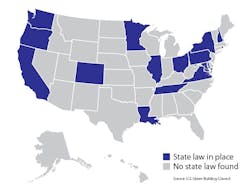Is the drinking water at your educational facility safe? A new report finds that only 15 states and Washington, D.C., have laws to mandate or encourage lead testing in school water, despite many health risks.
The report – from the U.S. Green Building Council’s (USGBC) Center for Green Schools – comes on the heels of news that water fountains in Detroit Public Schools Community District have been dry since classes began in August, according to the New York Times, after testing found elevated levels of copper and lead in the drinking water at some schools.
The 15 states included in the report are:
- California
- Colorado
- Illinois
- Louisiana
- Maryland
- Minnesota
- New Hampshire
- New York
- Ohio
- Oregon
- Pennsylvania
- Rhode Island
- Tennessee
- Virginia
- Washington
The report also notes that even those states that do have lead testing laws for schools, not all of them require testing or parental notification of all results. Gaps were found between federal, state and local regulations that result in most schools’ drinking water outlets being left untested.
“Access to safe drinking water is a fundamental human right, and every school that has not been tested could potentially be exposing students to contaminated water and the risk of adverse health effects,” says Anisa Heming, director of the Center for Green Schools.
Help BUILDINGS Shape 2019!
What BUILDINGS resources are most valuable to you? What would you like to see us provide?
Please take our short (under 2 minutes) survey - just 5 short questions.
Thank you!
Not long after the switch, residents began to notice that the water looked, smelled and tasted different.
(Photo: Ypsilanti, MI; Jan. 27, 2016: Sign at UAW local asking for donations for the Flint water crisis. The water in Flint has high levels of lead causing a health crisis. Shutterstock)
The following year, the U.S. Environmental Protection Agency (EPA) and Virginia Tech conducted a test and found dangerous levels of lead in the water at residents’ homes.
[On a positive note: How School District Cut 62 Percent in Energy Spending]
USGBC notes that laws for lead testing in school drinking water are “very new.” The earliest was enacted in Ohio in 2016 and the most recent was enacted in 2018 in Pennsylvania.
Drinking water contamination is a serious risk – especially for children because, according to the report, they can absorb four to five times more ingested lead into their bodies than adults from a given source.
“Additionally, children are more vulnerable to the neurotoxic effect of lead because their blood-brain barrier and live detoxification systems are not fully developed,” the report says.
Even low levels of lead exposure have been linked to damage of the central and peripheral nervous system, learning disabilities, shorter stature, impaired hearing, and impaired formation and function of blood cells.
“Access to safe drinking water is a fundamental human right, and every school that has not been tested could potentially be exposing students to contaminated water and the risk of adverse health effects,” says Anisa Heming, director of the Center for Green Schools.
Lead is colorless and odorless, and it can contaminate water at any point between distribution and a child ingesting water – which means it can be in service lines, building pipes and fittings, and sink fixtures.
[Read also: Tips to Move Your Building Toward Net Zero]
What Can You Do?
For a facilities manager, occupant safety is paramount, and avoiding water contamination should be a priority.
Take extra precautions – especially if your state isn’t on the list above – by doing the following tasks, as advised by the EPA and the Centers for Disease Control:
-
Keep up to date on the maintenance of your water pipes. When were they last monitored? When were the most recent plumbing repairs made?
-
Make sure your water fountains are routinely cleaned with disinfectant.
-
Take water samples and test using a testing kit or certified laboratory. Keep organized records of results.
-
Indicate that bathroom sinks are hand-washing only sinks. For small children, use pictures, such as this one provided by the EPA.
-
Check with local and state authorities about regulations that affect your facility.
Two handpicked articles to read next:
About the Author

Sarah Kloepple
Associate Editor
Sarah joined the BUILDINGS team as an associate editor in August 2018. She is a graduate of the Missouri School of Journalism, where her focus was magazine writing. She's written and edited for numerous publications in her hometown of St. Louis.

